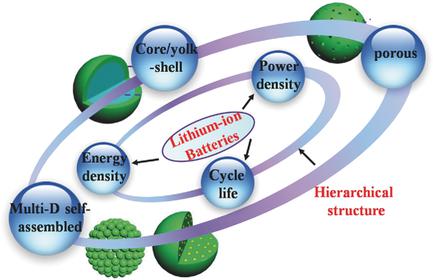当前位置:
X-MOL 学术
›
Adv. Energy Mater.
›
论文详情
Our official English website, www.x-mol.net, welcomes your feedback! (Note: you will need to create a separate account there.)
Recent Developments on and Prospects for Electrode Materials with Hierarchical Structures for Lithium‐Ion Batteries
Advanced Energy Materials ( IF 27.8 ) Pub Date : 2017-11-16 , DOI: 10.1002/aenm.201701415 Limin Zhou 1, 2 , Kai Zhang 3 , Zhe Hu 4 , Zhanliang Tao 1 , Liqiang Mai 2 , Yong-Mook Kang 3 , Shu-Lei Chou 1, 4 , Jun Chen 1
Advanced Energy Materials ( IF 27.8 ) Pub Date : 2017-11-16 , DOI: 10.1002/aenm.201701415 Limin Zhou 1, 2 , Kai Zhang 3 , Zhe Hu 4 , Zhanliang Tao 1 , Liqiang Mai 2 , Yong-Mook Kang 3 , Shu-Lei Chou 1, 4 , Jun Chen 1
Affiliation

|
Since their successful commercialization in 1990s, lithium‐ion batteries (LIBs) have been widely applied in portable digital products. The energy density and power density of LIBs are inadequate, however, to satisfy the continuous growth in demand. Considering the cost distribution in battery system, it is essential to explore cathode/anode materials with excellent rate capability and long cycle life. Nanometer‐sized electrode materials could quickly take up and store numerous Li+ ions, afforded by short diffusion channels and large surface area. Unfortunately, low thermodynamic stability of nanoparticles results in electrochemical agglomeration and raises the risk of side reactions on electrolyte. Thus, micro/nano and hetero/hierarchical structures, characterized by ordered assembly of different sizes, phases, and/or pores, have been developed, which enable us to effectively improve the utilization, reaction kinetics, and structural stability of electrode materials. This review summarizes the recent efforts on electrode materials with hierarchical structures, and discusses the effects of hierarchical structures on electrochemical performance in detail. Multidimensional self‐assembled structures can achieve integration of the advantages of materials with different sizes. Core/yolk–shell structures provide synergistic effects between the shell and the core/yolk. Porous structures with macro‐, meso‐, and micropores can accommodate volume expansion and facilitate electrolyte infiltration.
中文翻译:

锂离子电池分层结构电极材料的最新研究与展望
自1990年代成功商业化以来,锂离子电池(LIB)已广泛应用于便携式数字产品。但是,LIB的能量密度和功率密度不足以满足需求的持续增长。考虑到电池系统中的成本分配,必须探索具有出色的倍率能力和长循环寿命的阴极/阳极材料。纳米级的电极材料可以迅速吸收并存储大量的Li +短扩散通道和大表面积提供的离子。不幸的是,纳米颗粒的低热力学稳定性导致电化学附聚并且增加了在电解质上发生副反应的风险。因此,已经开发出以不同大小,相和/或孔的有序组装为特征的微/纳米和杂/分层结构,这使我们能够有效地提高电极材料的利用率,反应动力学和结构稳定性。这篇综述总结了最近对具有分层结构的电极材料的研究,并详细讨论了分层结构对电化学性能的影响。多维自组装结构可以实现不同尺寸材料的优点的整合。核/蛋黄-壳结构在壳与核/蛋黄之间提供协同作用。具有大孔,中孔和微孔的多孔结构可容纳体积膨胀并促进电解质渗透。
更新日期:2017-11-16
中文翻译:

锂离子电池分层结构电极材料的最新研究与展望
自1990年代成功商业化以来,锂离子电池(LIB)已广泛应用于便携式数字产品。但是,LIB的能量密度和功率密度不足以满足需求的持续增长。考虑到电池系统中的成本分配,必须探索具有出色的倍率能力和长循环寿命的阴极/阳极材料。纳米级的电极材料可以迅速吸收并存储大量的Li +短扩散通道和大表面积提供的离子。不幸的是,纳米颗粒的低热力学稳定性导致电化学附聚并且增加了在电解质上发生副反应的风险。因此,已经开发出以不同大小,相和/或孔的有序组装为特征的微/纳米和杂/分层结构,这使我们能够有效地提高电极材料的利用率,反应动力学和结构稳定性。这篇综述总结了最近对具有分层结构的电极材料的研究,并详细讨论了分层结构对电化学性能的影响。多维自组装结构可以实现不同尺寸材料的优点的整合。核/蛋黄-壳结构在壳与核/蛋黄之间提供协同作用。具有大孔,中孔和微孔的多孔结构可容纳体积膨胀并促进电解质渗透。


























 京公网安备 11010802027423号
京公网安备 11010802027423号